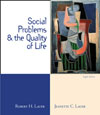CHAPTER 11 Work and the Economy The Economy, Work, and the Work Force in America (pp. 367-372) The American economy, the nature of work, and the nature of the work force
are vastly different today from what they were at various times in the past.
American industrialization occurred in the context of capitalism. The
global economy has become particularly important. Globalization means
that businesses find low-skilled workers in other nations who work for lower
pay than do Americans. In the competitive context of the global economy, a number
of changes have occurred that are detrimental to the well-being of many American
workers, including downsizing. The labor force has increased enormously
over time. Since at least 1940, the labor force has been growing faster than
the population. There are now more than 30,000 occupational categories, which
reflects an increased division of labor and work specialization. Since 1900,
sharp increases have occurred in the numbers of professionals, managers, clerical
workers, and service workers, and declines in the numbers of private household
workers, farmers, and farm workers. The education level of the work force has
been increasing, women's participation in the labor force has been expanding
rapidly, and union membership appears to have declined in the last decade. Many
observers argue that the work ethic has declined and that Americans increasingly
value their leisure time. But, Americans are not rejecting work; they are rejecting
meaningless work and low-quality jobs. Work as a Social Problem (pp. 372-377) There are three basic problems associated with work in America today: unemployment
and underemployment, dissatisfaction and alienation, and work hazards.
In 1998, 4.8 million Americans were not in the labor force but indicated that
they "want a job now." Rates of unemployment are higher for youth, African Americans,
women, and blue-collar workers. In general, expanding job categories have lower
unemployment rates. Many workers are alienated, but studies show greatest satisfaction
among professional and white-collar workers. In 1998, 5.9 million injuries and
illnesses occurred in private industry workplaces. Work hazards produce work-induced
stress. Work and the Quality of Life (pp. 377-382) Ironically, both working and not working can have adverse effects on people's
health. Work can have a negative impact on the emotional and physical well-being
of workers through feelings of alienation and high levels of job dissatisfaction.
The stress of being forcibly unemployed can be as serious as the stress of working
in undesirable conditions or in an unfulfilling job; it is detrimental to both
physical and emotional well-being. Work-related stress can also adversely affect
interpersonal relationships. Contributing Factors (pp. 382-391) People in a capitalist economy are motivated by profit: workers' needs
are subservient to organizational needs, as reflected in practices like union-busting,
downsizing, and the use of temporary workers. It is important to understand
the political economy of work, of unemployment, and of work hazards. There is
a basic contradiction between the values of hard work and the American dream
of success: The job market cannot meet this expectation. Alienation and job
dissatisfaction are inevitable due to the nature of the work roles and work
environments in contemporary society. The labor market cannot deliver jobs that
fully employ a highly educated labor force. Technology leads to tasks that are
highly specialized, repetitious, boring, and depersonalized-an especially severe
problem for blue-collar workers. Some jobs necessarily entail more risk than
others. American ideology emphasizes the value of all work, yet equal value
is not assigned to all forms of work. What Is to Be Done? (pp. 391-393) Problems of worker dissatisfaction and alienation can be addressed through
job enrichment, flextime, participatory management, and employee ownership.
Innovations such as these appear to yield higher productivity, lower costs,
and increased worker satisfaction, but these measures draw skepticism and resistance
from some Americans, including those in management. |



 2002 McGraw-Hill Higher Education
2002 McGraw-Hill Higher Education